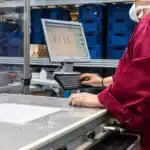Additive technology
High-tech Printed Electronics, PTF flexible heaters and flexible printed circuits
Flexible heaters and circuits of every kind
Innovation is our strength and our constant promise. Alper’s PTF flexible heaters and flexible printed circuits keep faith with this commitment because, every day, we field the best technology and quality to produce ever-higher performance ultra-flat heating elements, circuits and sensors.
Alper develops and prints ultra-thin flexible heaters and circuits on very thin substrates, such as PET sheets, making the product extremely flexible and adaptable to any type of cylindrical curvature. The advantage? These types of sensors and heating elements are so versatile that they can be used in a wide range of industries, meeting numerous applications needs in both the industrial and consumer goods sectors.
The technology of flexible adhesive heaters
Alper produces ultra-thin resistive heaters (starting at 0.2 mm) on polymer film, using screen-printed conductive inks and pastes, adaptable to final products. Thanks to the use of carbon paste, resistance values can vary up to 20% in ohmic values without changing equipment. These heaters operate across a broad ohmic and temperature range, reaching up to approximately 100°C.
Three revolutionary surface heater solutions designed to warm efficiently
Alper printed heater types include:
- Polyester and carbon heaters: uniform heating, the carbon ink combines flexibility and efficiency ensuring a slight “PTC effect”
- Silver ink heaters: offer rapid heating and precisely printed tracks. Discover all the potential and advantages of silver, whose excellent heat conduction ensures not only a fast heating of the resistances, but also an even distribution of heat, ensuring maximum efficiency.
- “Self-limiting” PTC carbon ink heaters: as the system temperature increases, the PTC heater increases its resistivity, resulting in a decrease in its power. This particularity, which distinguishes these flexible heaters Alper, makes them suitable for the most special and delicate applications, such as those in contact with skin and fabrics.
These three different technologies offer an anti frost function preventing and defrosting ice buildups to guarantee a frost-free environment in cold climates.

The 7 advantages of alper heating elements compared to traditional ones:
- Alper heating elements can be adapted to curved surfaces or inserted in tight spaces because they are printed on a thin, flexible support.
- They can also feature holes or slits for applications that require them.
- They reach the desired temperature quickly and consumption is limited.
- They can provide differentiated heat generation. How? Simply by increasing or decreasing element printing density depending on where and how much you want to heat.
- They stick to a variety of surfaces as one (or both) of the two sides can be made adhesive.
- They’re designed for various types of electrical insulation, according to the environment where they must work.
- They can be produced with any power supply voltage, including low voltage.







